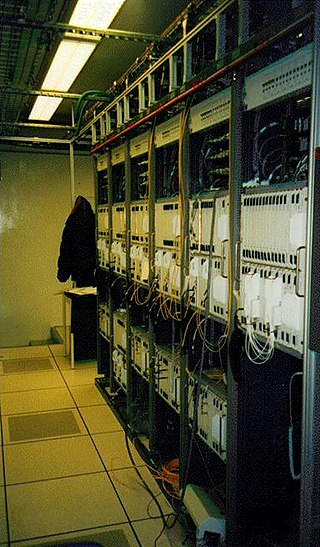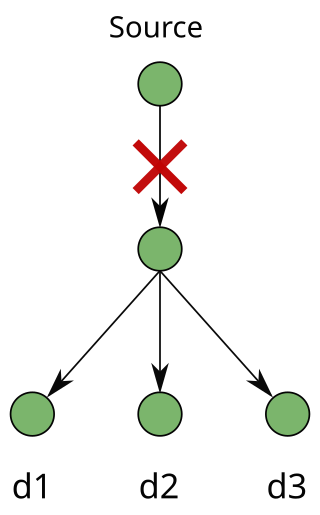In optical networking, a lightpath is a path between two nodes in an optical network between which light passes through unmodified.
In optical networking, a lightpath is a path between two nodes in an optical network between which light passes through unmodified.
When a lightpath can be established between source and destination node endpoints the connection is totally optical and avoids throttling by intermediate electronic conversions and processing. [1] Where a lightpath passes through an Optical add-drop multiplexer (OADM) is known as a cut-through lightpath. Where a lightpath is added or dropped at an OADM, it is known as an added/dropped lightpath. [2]
Where endpoints are connected by a series of lightpaths with the intermediate nodes only changing the light wavelength at the junctions this may be referred to as a semi-lightpath. [3]
Routing is the process of selecting a path for traffic in a network or between or across multiple networks. Broadly, routing is performed in many types of networks, including circuit-switched networks, such as the public switched telephone network (PSTN), and computer networks, such as the Internet.

Synchronous Optical Networking (SONET) and Synchronous Digital Hierarchy (SDH) are standardized protocols that transfer multiple digital bit streams synchronously over optical fiber using lasers or highly coherent light from light-emitting diodes (LEDs). At low transmission rates data can also be transferred via an electrical interface. The method was developed to replace the plesiochronous digital hierarchy (PDH) system for transporting large amounts of telephone calls and data traffic over the same fiber without the problems of synchronization.

Network topology is the arrangement of the elements of a communication network. Network topology can be used to define or describe the arrangement of various types of telecommunication networks, including command and control radio networks, industrial fieldbusses and computer networks.

In fiber-optic communications, wavelength-division multiplexing (WDM) is a technology which multiplexes a number of optical carrier signals onto a single optical fiber by using different wavelengths of laser light. This technique enables bidirectional communications over a single strand of fiber as well as multiplication of capacity.
Traffic grooming is the process of grouping many small telecommunications flows into larger units, which can be processed as single entities. For example, in a network using both time-division multiplexing (TDM) and wavelength-division multiplexing (WDM), two flows which are destined for a common node can be placed on the same wavelength, allowing them to be dropped by a single optical add-drop multiplexer. Often the objective of grooming is minimizing the cost of the network. The cost of line terminating equipment (LTE) is the most dominant component in an optical WDM network's cost. Thus grooming typically involves minimizing the usage of ADMs.
Optical burst switching (OBS) is an optical networking technique that allows dynamic sub-wavelength switching of data. OBS is viewed as a compromise between the yet unfeasible full optical packet switching (OPS) and the mostly static optical circuit switching (OCS). It differs from these paradigms because OBS control information is sent separately in a reserved optical channel and in advance of the data payload. These control signals can then be processed electronically to allow the timely setup of an optical light path to transport the soon-to-arrive payload. This is known as delayed reservation.

A passive optical network (PON) is a fiber-optic telecommunications network that uses only unpowered devices to carry signals, as opposed to electronic equipment. In practice, PONs are typically used for the last mile between Internet service providers (ISP) and their customers. In this use, a PON has a point-to-multipoint topology in which an ISP uses a single device to serve many end-user sites using a system such as 10G-PON or GPON. In this one-to-many topology, a single fiber serving many sites branches into multiple fibers through a passive splitter, and those fibers can each serve multiple sites through further splitters. The light from the ISP is divided through the splitters to reach all the customer sites, and light from the customer sites is combined into the single fiber. Many fiber ISPs prefer this system.
The routing and wavelength assignment (RWA) problem is an optical networking problem with the goal of maximizing the number of optical connections.
In fiber optics, a reconfigurable optical add-drop multiplexer (ROADM) is a form of optical add-drop multiplexer that adds the ability to remotely switch traffic from a wavelength-division multiplexing (WDM) system at the wavelength layer. This is achieved through the use of a wavelength selective switching module. This allows individual or multiple wavelengths carrying data channels to be added and/or dropped from a transport fiber without the need to convert the signals on all of the WDM channels to electronic signals and back again to optical signals.
Optical networking is a means of communication that uses signals encoded in light to transmit information in various types of telecommunications networks. These include limited range local-area networks (LAN) or wide area networks (WANs), which cross metropolitan and regional areas as well as long-distance national, international and transoceanic networks. It is a form of optical communication that relies on optical amplifiers, lasers or LEDs and wavelength-division multiplexing (WDM) to transmit large quantities of data, generally across fiber-optic cables. Because it is capable of achieving extremely high bandwidth, it is an enabling technology for the Internet and telecommunication networks that transmit the vast majority of all human and machine-to-machine information.
An optical cross-connect (OXC) is a device used by telecommunications carriers to switch high-speed optical signals in a fiber optic network, such as an optical mesh network.

An optical add-drop multiplexer (OADM) is a device used in wavelength-division multiplexing (WDM) systems for multiplexing and routing different channels of light into or out of a single-mode fiber (SMF). This is a type of optical node, which is generally used for the formation and the construction of optical telecommunications networks. "Add" and "drop" here refer to the capability of the device to add one or more new wavelength channels to an existing multi-wavelength WDM signal, and/or to drop (remove) one or more channels, passing those signals to another network path. An OADM may be considered to be a specific type of optical cross-connect.

Fiber-optic communication is a method of transmitting information from one place to another by sending pulses of infrared or visible light through an optical fiber. The light is a form of carrier wave that is modulated to carry information. Fiber is preferred over electrical cabling when high bandwidth, long distance, or immunity to electromagnetic interference is required. This type of communication can transmit voice, video, and telemetry through local area networks or across long distances.

EMMAN was a company limited by guarantee and jointly owned by its members, eight Higher Education Institutions in the East Midlands region of the United Kingdom.
Wavelength selective switching components are used in WDM optical communications networks to route (switch) signals between optical fibres on a per-wavelength basis.

An optical mesh network is a type of optical telecommunications network employing wired fiber-optic communication or wireless free-space optical communication in a mesh network architecture.

Wavelength switched optical network (WSON) is a type of telecommunications network.
Shared risk resource group is a concept in optical mesh network routing that different networks may suffer from a common failure if they share a common risk or a common SRG. SRG is not limited to optical mesh networks: SRGs are also used in MPLS, IP networks, and synchronous optical networks.

A multicast session requires a "point-to-multipoint" connection from a source node to multiple destination nodes. The source node is known as the root. The destination nodes are known as leaves. In the modern era, it is important to protect multicast connections in an optical mesh network. Recently, multicast applications have gained popularity as they are important to protecting critical sessions against failures such as fiber cuts, hardware faults, and natural disasters.
Link protection is designed to safeguard networks from failure. Failures in high-speed networks have always been a concern of utmost importance. A single fiber cut can lead to heavy losses of traffic and protection-switching techniques have been used as the key source to ensure survivability in networks. Survivability can be addressed in many layers in a network and protection can be performed at the physical layer, Layer 2 and Layer 3 (IP).